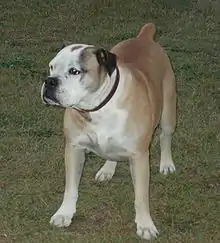| Campeiro Bulldog | |||||||||||||||||||||||||
|---|---|---|---|---|---|---|---|---|---|---|---|---|---|---|---|---|---|---|---|---|---|---|---|---|---|
 | |||||||||||||||||||||||||
| Other names | Portuguese: Buldogue Campeiro | ||||||||||||||||||||||||
| Origin | Brazil | ||||||||||||||||||||||||
| |||||||||||||||||||||||||
| |||||||||||||||||||||||||
| Dog (domestic dog) | |||||||||||||||||||||||||
The Campeiro Bulldog (Portuguese: Buldogue campeiro, Portuguese pronunciation: [buwˈdɔɡ kãˈpejɾu]) is a breed of bulldog from Brazil.
Overview
The Campeiro Bulldog was traditionally used in Brazil as a catch dog, catching and holding cattle, often in slaughterhouses.[1] In the 1970s the use of such dogs was banned in Brazilian slaughterhouses and the breed's number declined to the point of extinction, this was further exacerbated by the increased popularity of imported dog breeds.[1] In the mid-1970s a private breeding program was commenced to save the breed and numbers have gradually recovered, the breed was recognised by the Confederação Brasileira de Cinofilia in 2001.[1]
According to the Confederação Brasileira de Cinofilia's breed standard, Campeiro Bulldogs typically stand between 48 and 56 centimetres (19 and 22 in), with dogs standing between 50 and 56 centimetres (20 and 22 in) and bitches between 48 and 54 centimetres (19 and 21 in).[2] The breed standard states healthy adult dogs typically weigh between 36 and 42 kilograms (79 and 93 lb) and bitches between 31 and 37 kilograms (68 and 82 lb).[2] The breed standard states the breed has a short, smooth coat that can be any colour except merle.[2]
The breed is known to be aggressive to other dogs.[1]
See also
References
- 1 2 3 4 Truda, Felipe (25 August 2013). "Criador diz ter percorrido o RS para salvar bulldog campeiro da extinção" [Dog breeder says to have traveled the RS to save the Campeiro Bulldog of the extinction]. G1 (in Portuguese). Rio de Janeiro. Retrieved 24 March 2021.
- 1 2 3 "Padrão Oficial da Raça: Buldogue Campeiro" [Official Breed Standard: Campeiro Bulldog] (PDF). Confederação Brasileira de Cinofilia (in Portuguese). 28 January 2019. Retrieved 25 March 2021.